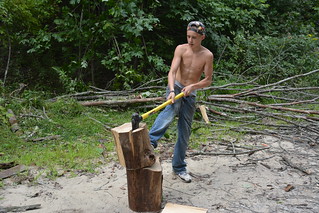Over the past few months, outdoor activities with local youth have developed into a new project, the Youth Engagement Project (YEP). RAMPS members have been making trips with local youth to find downed trees in the forests surrounding Whitesville, then cutting and splitting it into pieces that are sold as firewood. Some of the wood is also given directly to the families of youth involved in the project. Here in the mountains, firewood is not just easy to find, it’s also a part of this culture: using chainsaws, mauls, and woodstoves is a part of the mountain way of life. The youth who are participating in YEP have a lot of fun getting outside and like having a way to earn some spending money; they’re also very proud of their accomplishments.

A firewood crew on a wood-collecting trip

A youth digs for some yellowroot
YEP outings also include root-digging days in which RAMPS travel with local youth to places in the forest where medicinal herbs, such as yellowroot (Hydrastis canadensis) and bloodroot (Sanguinaria canadensis), can be gathered. In the process, youth travel through areas where the destructive impacts of the coal and gas industries are visible as well as to older, more intact forests ecosystems where most commercially valuable wild roots are found. After the roots are gathered and dried, RAMPS also help the youth to get their roots to market. We’re especially excited to engage local youth with projects that get them outside, equip them with skills they can apply outside our program, and teach them more about the land surrounding our area. Since we like to incorporate general learning about the forest into the program, YEP will collaborate with other adults in the community to teach the youth to identify different plant species.
The RAMPS office in Whitesville is a hub for bicycle repairs. RAMPS offers tools and mechanical support.
Youth projects aren’t restricted to forest outings, and we’re still expanding our nascent projects. Some of the wood we gather is usable for lumber, and so YEP is considering milling some wood with our chainsaw mill to build a woodshed and improve our water catchment system. We’ve also received a grant to build a community garden and to grow some more veggies here in raised beds on some vacant lots in town–just in time for fall crops! The garden which will consist partly of individual beds for people in the community and partly of a ‘community bed’ which will be used to provide fresh vegetables to families in need during growing season as well as vegetables for canning to provide food in colder months. As a collective, we’re excited to see where else this budding project branches out in the future.


